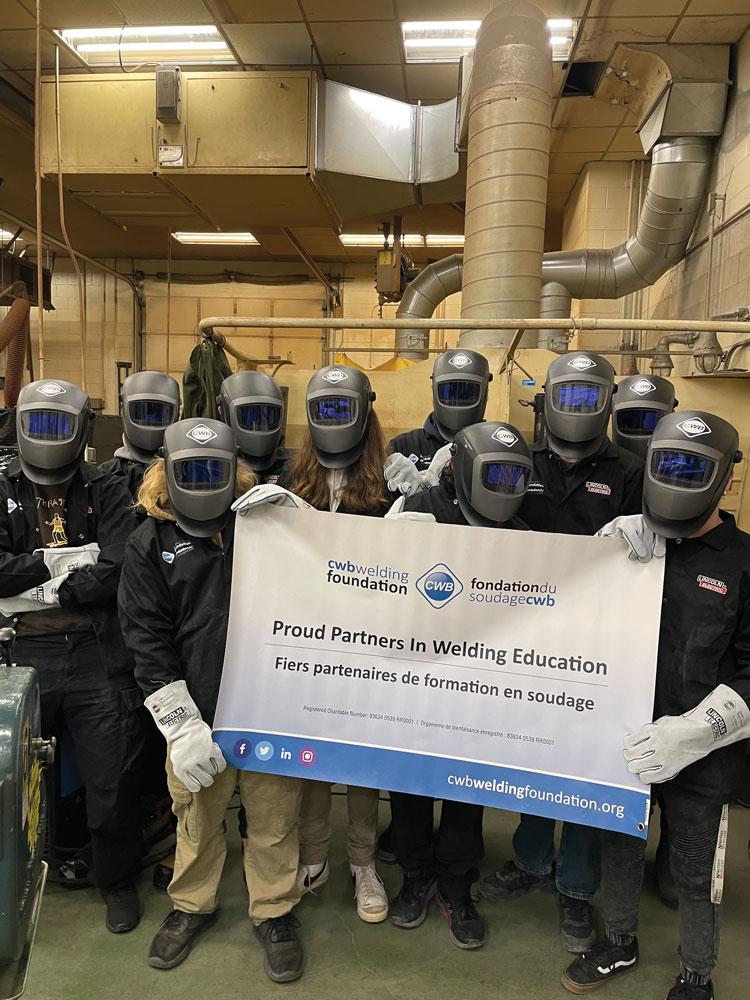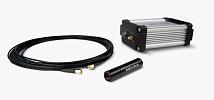Editor
- FMA
- The Fabricator
- FABTECH
- Canadian Metalworking
CWB Welding Foundation celebrates 10 years of supporting industry
Executive Director Susan Crowley explains how the foundation has adapted to succeed in its mission
- By Rob Colman
- June 14, 2023
- Article
- Welding

One of the foundation’s many outreach efforts has been the creation of the CWB WeldSAFE program, which provides high school students with personal protective equipment (PPE) kits and promotes welding safety. CWB WeldSAFE program was created in partnership with the International Brotherhood of Boilermakers, AltaGas, 3M Canada, Lincoln Electric, and Weldready. Image: CWB
In 2023, the CWB Welding Foundation celebrates its 10th anniversary as a national not-for-profit charity focused on breaking barriers and bridging skill gaps in welding and welding-related industries. Since its inception in 2013, it has been committed to raising awareness, advocating for the welding industry, delivering hands-on educational programs, and investing in educational infrastructure to address the shortage of skilled professionals in Canada.
Adapting to Needs
The method of delivering these programs has adapted to landscape and community needs. From its Mind Over Metal camps, which first rolled out eight years ago to encourage the engagement of young people in the trades, to its Women of Steel programs, which not only created opportunities for women to try the trade but also offers associated wraparound support programs to keep them engaged, the foundation has discovered ways to reach out and create interest among under-recognized demographics.
“It’s exciting times,” said Susan Crowley, executive director of the foundation. “When I first joined the organization, I was looking at this as an opportunity to clarify the role of the foundation going forward. I feel like we've built a wonderful team that is well aligned with our board of directors and the larger CWB Group leadership and board. We’re in the strategic planning process right now, as part of the larger CWB Group, determining our aspirations and planning for further impact over the next 10 years. Most recently, CWB Group affiliated itself with the Edison Welding Institute (EWI) in the U.S., and it’s great to be part of the team scoping out where this and other new opportunities might come from and take us.”
Crowley noted that the foundation’s success is really built on partnerships – first and foremost with the CWB Group and the CWB Association, but also critically, with educational institutions across Canada, government, other not-for-profit organizations, and private industry.
“It’s very difficult to roll out these programs alone,” she said. “I feel that we’ve created a wonderful snowball effect throughout industry. A lot of businesses need welders, welding engineers, and fabricators, and they are supporting what we are trying to do to fill that pipeline, from the awareness-building stage with students in elementary and secondary schools, right through to the secondary and post-secondary educator community.”
One of the key differentiators in its delivery of programs has been the flexibility to adapt to community needs. For instance, last year the foundation supported a mobile welding school that moves between locations in New Brunswick, creating an opportunity for students in a number of rural and remote communities to experience welding in a way that made it viable in communities that couldn’t afford the initial investment of full welding classroom facilities.
“Whatever we do, we have to be regionally focused,” said Crowley. “Our call-out brand or phrase for that is ‘Sparking Success.’ What that means for us is making a multi-year, multi-party commitment to developing talent regionally across Canada, making the educational requirements to be a welder or welding engineer accessible to the people who live in that region, with links to industry and labour. That can be through a mobile trailer or through welding simulation experiences and hands-on educational programs. And it can be through working with partners to bring students to a place that is well equipped, both from an educator standpoint and facilities standpoint, to impart the training to them in a way that makes sense.”
As noted, the CWB Foundation’s programs have broadened over the past 10 years to include pre-employment and upskilling programs, recognizing that the point of entry, re-entry, and advancement within a skilled trades career can be varied.
“We’re seeing very high completion rates in these programs as well,” Crowley noted. “We have an 87 per cent success rate among participants in our programs that lead to a CWB certification.”
Crowley estimated that more than 10,000 welding students and educators have been touched by the Ffundation’s efforts in some form or another in the past 10 years.
“Just as important, we hope that we are having an indirect influence on the perception of the welding trade as a viable, valuable alternative to other educational paths,” said Crowley. “Welding career opportunities match what many young students are striving for. When we give them the knowledge of what those opportunities are, everyone wins. We’re tremendously thankful for the efforts of so many partners to change the narrative about careers in trades, and [we are] seeing significant growth in program enrollment at the secondary level as students learn about the opportunities to explore their interests and build amazing careers.”
Mentorship Moves
Asked what’s next, Crowley said that creating mentorship opportunities is one key goal the foundation hopes to create for Canada’s future welding workforce.
“We began creating mentorship opportunities through our Women of Steel program, but we realize that all young welders could benefit from having the support of an older mentor in industry to guide them in understanding the industry—both opportunities as well as challenges. We are working to expand those opportunities.”
If you as an individual or business owner want to get involved with the foundation, Crowley encourages you to engage with the CWB Association as a first step.
“We work closely with them,” she noted. “They also partner with us and support our program—especially student awards and secondary school support in the areas in which their members live and work. So I think No. 1 is we would encourage people to seek out the CWB Association for all of the things that they can learn and do together.
“But we're always keen to hear from welding students and professionals as to their interest in volunteering with us and being a part of our community.
“We are currently trying to link mentors with mentees as well, and we will be expanding across Canada over the next year or so as a key priority because there's definitely an interest in speaking to people who have the knowledge from industry for advice, especially when you're just starting your career. So we encourage you to reach out and let us know if you would like to serve as a mentor.”
If you’ve benefited from a CWB Foundation program in the past, they also would love to hear from you so that you can share the impact it has had on your career.
Currently, the organization, in collaboration with CWB Education, is preparing for its annual Welding Educator’s Conference, which will take place in person for the first time since the start of the pandemic, this time at Mohawk College, in Stoney Creek, Ont., June 6-8. If you are an educator interested in improving welding education in your school or board, visit the foundation website to see how you can take part.
For more information about the CWB Welding Foundation and its programs, visit www.cwbweldingfoundation.org.
Editor Robert Colman can be reached at rcolman@canadianfabweld.com.
About the Author

Rob Colman
1154 Warden Avenue
Toronto, M1R 0A1 Canada
905-235-0471
Robert Colman has worked as a writer and editor for more than 25 years, covering the needs of a variety of trades. He has been dedicated to the metalworking industry for the past 13 years, serving as editor for Metalworking Production & Purchasing (MP&P) and, since January 2016, the editor of Canadian Fabricating & Welding. He graduated with a B.A. degree from McGill University and a Master’s degree from UBC.
subscribe now


Keep up to date with the latest news, events, and technology for all things metal from our pair of monthly magazines written specifically for Canadian manufacturers!
Start Your Free Subscription- Trending Articles
Aluminum MIG welding wire upgraded with a proprietary and patented surface treatment technology

Hypertherm Associates partners with Rapyuta Robotics

Protected and productive: welding helmet tech

HGG Profiling Equipment BV names Western Canada area sales manager

Compact weld camera monitors TIG, plasma processes

- Industry Events
CTMA Economic Uncertainty: Helping You Navigate Kitchener Seminar
- May 2, 2024
- Kitchener, ON Canada
Automate 2024
- May 6 - 9, 2024
- Chicago, IL
ANCA Open House
- May 7 - 8, 2024
- Wixom, MI
17th annual Joint Open House
- May 8 - 9, 2024
- Oakville and Mississauga, ON Canada
MME Saskatoon
- May 28, 2024
- Saskatoon, SK Canada















